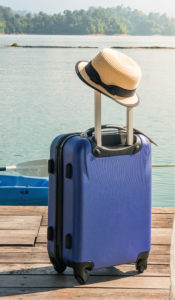What are the common ear problems faced by individuals?
Ear issues such as ear wax impaction, blocked ears and water-clogged ears are common problems which may be faced by individuals in their life.
In the United Kingdom, about 2.3 million people suffer from ear wax impaction. The prevalence of ear wax impaction in the USA is around 10% among children, 5% among healthy adult, and up to 57% in older persons in nursing homes.
It is important to note that treatment of the ear problems with non-prescription products is subjected to many limitations as only a small number of conditions can be self-treated.
More serious conditions must be referred as additional medical treatment such as antibiotics or antifungal ear drops might be required. These include:
- Swimmer’s ear (bacterial infection of the outer ear canal)
- Loss of hearing
- Abnormal ear discharge
- Ear pain not due to ear wax impaction
- Rash in ear
- Perforated eardrum
Ear Wax Impaction?
What is it?
The ear canal consists of several specialised structures that act together to produce ear wax. Ear wax coats and lubricates the external auditory canal, providing a protective barrier against infection. Ear wax does not usually cause problems. However, producing too much ear wax can lead to itching of the ear, pain, tinnitus, dizziness, cough, vertigo, and increased risk of infection.
Risk factors:
It can be a result of ineffective attempts to remove ear wax with cotton-tipped swabs or applicators. While a bit of ear wax does discolour the applicator (brownish appearance after digging the ears), the bulk of the more solid mass of ear wax is pushed further into the ear by the applicator and is hardened. The natural movement of ear wax towards the outer part of ear canal (ceruminokinesis) is unable to move this harder wax and the impaction results.
Hearing aid and earplug users are also more prone to ear wax blockage.
Management methods:
Many cases of ear wax blockage respond to home treatments.
- Use a few drops of olive oil, mineral oil, baby oil, or glycerin in the ear to soften the wax. Hydrogen peroxide drops can also be used.
- Common ear drops available in pharmacies contain docusate sodium and glycerol to aid in softening ear wax.
- Ear irrigation products. These self-treatment measures may be used regularly, especially if the patient experiences ear wax build-up often.
Mild blocked ears (Eustachian tube blockage)
What is it?
The eustachian tube which is located at the back of the nose next to the root of mouth ends in the middle ear space. The main function of the Eustachian tube is to ventilate the middle ear space, ensuring that the pressure remains at near normal air pressure. Eustachian tube can be blocked for a variety of reasons including sinus infections and allergies which can cause swelling of the tissue lining. Changes in altitude when flying can also cause ear blockage.
Risk factors:
Those who have regular rhinitis symptoms and experience blocked nose frequently may be more susceptible to having blocked ears due to inflammation of the tissue lining. Sometimes, blocked ears may also be experienced during a flight when there is a change in pressure.
Management methods:
Individuals can try out the following methods:
- Swallowing, yawning and performing the valsalva manoeuvre (pinching of nose, closing mouth and forcefully breathing air out). These actions cause contractions of muscles located in the back of the throat and help regulate eustachian tube function.
- If this method does not work, oral decongestants (Such as: Pseudoephedrine, phenylephrine); nasal applications (Such as: phenylephrine, oxymetazoline, xylometazoline) can be used to shrink the membranes lining the nose and throat, allowing the ears to equalise more easily.
If these measures still do not provide relief, he/she should be referred to a doctor.
Water-clogged ears
What is it?
People with high water exposure (Such as swimmers, divers) are more prone to having water-clogged ears.
Risk factors:
In general, water can enter and exit the ear without any problems. However, there are times when water can penetrate into the ear canal, clogging the ear. This may cause reduced hearing and make the person more susceptible to ear infections.
Management methods:
Individuals can try out the following methods:
- Reducing water exposure: Wearing shower caps or ear putties while bathing or swimming
- If water has entered, tilting and shaking excess water from the ears may help.
- Instilling 2 to 5 drops of isopropyl alcohol, methylated spirit or a solution of equal part of alcohol and vinegar (50:50 mixture) with a dropper into the water-clogged ear can help to clear the ear as well.
Want to find out more?
You can visit your nearest Unity Pharmacy and approach our pharmacists or staff on duty for more information.
Reference
- Gabriel, O. (2015). Cerumen impaction: Challenges and management profile in a rural health facility. Nigerian Medical Journal, 56(6), 390. doi: 10.4103/0300-1652.171620
- Rainsbury, J. (2015). Faculty of 1000 evaluation for Interventions for adult Eustachian tube dysfunction: a systematic review. F1000 – Post-Publication Peer Review of the Biomedical Literature. doi: 10.3410/f.718495923.793503326
- , Greener, M., Robinson, A., & Smith, A. (2004). Impacted cerumen: composition, production, epidemiology and management. Qjm, 97(8), 477–488. doi: 10.1093/qjmed/hch082
- Alabi, B., Adegbiji, W., Olajuyin, O., & Nwawolo, C. (2014). Ear wax impaction: Symptoms, predisposing factors and perception among Nigerians. Journal of Family Medicine and Primary Care, 3(4), 379. doi: 10.4103/2249-4863.148116
- Martin, R. L. (2010). How to care for moist ears. The Hearing Journal, 63(3), 60. doi: 10.1097/01.hj.0000369569.29420.7a










